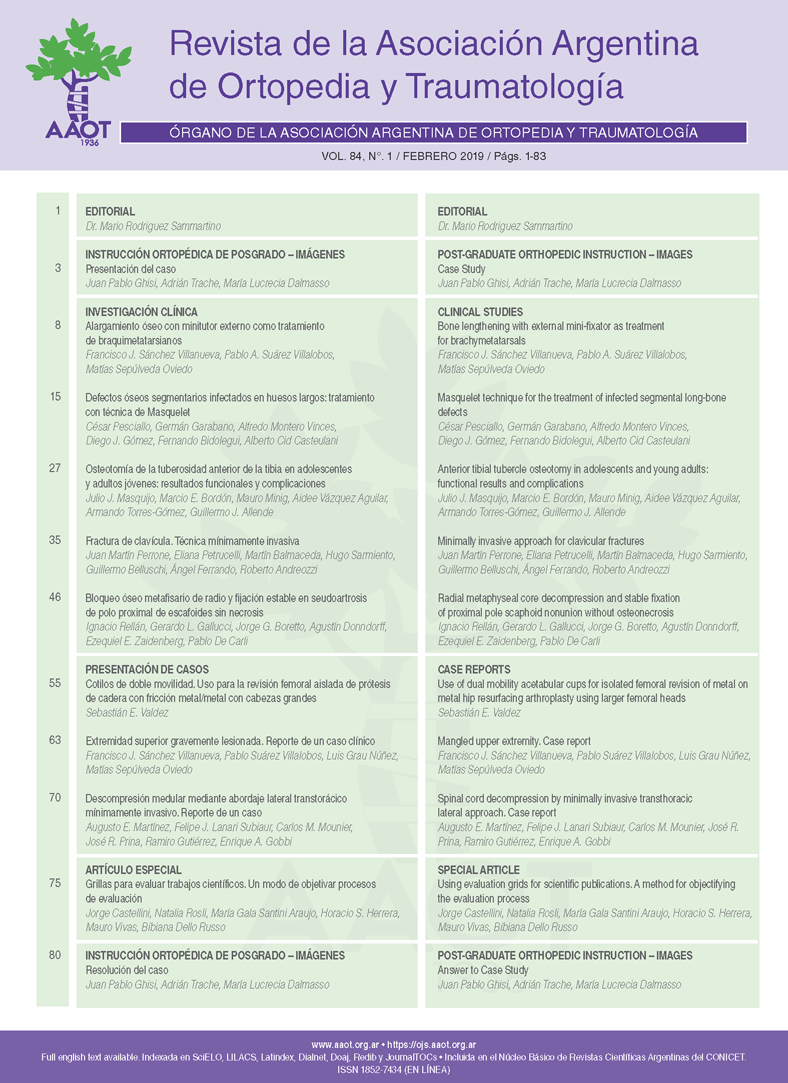Alargamiento óseo con minitutor externo como tratamiento de braquimetatarsianos. [Bone lengthening with external mini-fixator as treatment for brachymetatarsals]
Contenido principal del artículo
Resumen
Materiales y Métodos: Estudio descriptivo retrospectivo. Serie de casos. Se analizaron los resultados de los pacientes operados con esta técnica en nuestro Centro. Se analizaron 6 casos, dos con braquimetatarsia bilateral. Todas eran mujeres y tenían braquimetatarsia del 4.º metatarsiano. El promedio de edad era de 14 años. Se evaluaron los siguientes aspectos: alargamiento en milímetros y complicaciones, como retraso de la consolidación, infección, luxación metatarsofalángica, articulación metatarsofalángica en flexión y satisfacción del paciente.
Resultados: Se logró un alargamiento promedio de 15 mm. Dos pacientes tuvieron una infección superficial de las agujas. Una paciente evolucionó con luxación de la articulación metatarsofalángica; otra, con flexión de la articulación metatarsofalángica. No hubo complicaciones neurovasculares.
Conclusiones: El alargamiento óseo guiado con tutor externo es un tratamiento seguro y eficaz, además lograría un largo mayor en milímetros que el alargamiento en un tiempo, con un mejor control del alargamiento de partes blandas y estructuras neurovasculares. Todas las complicaciones se resolvieron de manera simple, no afectaron el resultado final del tratamiento. Las complicaciones concuerdan con las descritas en la literatura internacional.
ABSTRACT
Introduction: Brachymetatarsia is a shortening of any metatarsal bone, mainly due to premature growth arrest of the growth plate. It is more frequent in women, the fourth and the first metatarsal being the most affected bones. The aim of this study was to evaluate the outcomes of progressive bone lengthening with external mini-fixator.
Methods: This was a retrospective, descriptive, case series study in which we analyzed the outcomes of all patients operated on with this technique in our Center. Six cases were evaluated, two of which presented bilateral brachymetatarsia. All patients were women and had brachymetatarsia of the 4th metatarsal. The average age was 14 years. The following aspects were evaluated: lengthening in millimeters and presence of complications, such as delayed consolidation, infection, metatarsophalangeal joint dislocation, metatarsophalangeal joint flexion, and patient satisfaction.
Results: On average, an increase of 15 mm was achieved. Two cases presented superficial infection at the needle insertion site. One patient progressed to metatarsophalangeal joint dislocation, and another one to metatarsophalangeal joint flexion. No neurovascular complications were observed.
Conclusions: Bone lengthening with external fixator is a safe and effective treatment. A greater length in millimeters can be achieved in comparison to one-stage lengthening, as well as an improved soft-tissue and neurovascular stretching. All complications resolved smoothly and did not affect final treatment results. Complications are similar to those described in the international literature.
Descargas
Métricas
Detalles del artículo

Esta obra está bajo licencia internacional Creative Commons Reconocimiento-NoComercial-CompartirIgual 4.0.
La aceptación del manuscrito por parte de la revista implica la no presentación simultánea a otras revistas u órganos editoriales. La RAAOT se encuentra bajo la licencia Creative Commons 4.0. Atribución-NoComercial-CompartirIgual (http://creativecommons.org/licenses/by-nc-sa/4.0/deed.es). Se puede compartir, copiar, distribuir, alterar, transformar, generar una obra derivada, ejecutar y comunicar públicamente la obra, siempre que: a) se cite la autoría y la fuente original de su publicación (revista, editorial y URL de la obra); b) no se usen para fines comerciales; c) se mantengan los mismos términos de la licencia.
En caso de que el manuscrito sea aprobado para su próxima publicación, los autores conservan los derechos de autor y cederán a la revista los derechos de la publicación, edición, reproducción, distribución, exhibición y comunicación a nivel nacional e internacional en las diferentes bases de datos, repositorios y portales.
Se deja constancia que el referido artículo es inédito y que no está en espera de impresión en alguna otra publicación nacional o extranjera.
Por la presente, acepta/n las modificaciones que sean necesarias, sugeridas en la revisión por los pares (referato), para adaptar el trabajo al estilo y modalidad de publicación de la Revista.
Citas
2. Hosny GS, Ahmed AS. Distraction osteogenesis of fourth brachymetatarsia. Foot Ankle Surg 2016;22:12-6.
DOI: 10.1016/j.fas.2015.03.009
3. Kim HT, Lee SH, Yoo CI, Kang JH, Suh JT. The management of brachymetatarsia. J Bone Joint Surg Br
2003;85:683-90. DOI:10.1302/0301-620X.85B5.13733
4. Davidson RS. Metatarsal lengthening. Foot Ankle Clin 2001;6:499-518. DOI:10.1016/S1083-7515(03)00110-4
5. Baek GH, Chung MS. The treatment of congenital brachymetatarsia by one-stage lengthening. J Bone Joint Surg 1998;80:1040-4. DOI:10.1302/0301-620X.80B6.0801040
6. Jones MD, Pinegar DM, Rincker SA. Callus distraction versus single stage lengthening with bone graft for
treatment of brachymetatarsia: A systematic review. J Foot Ankle Surg 2015;54:927-31. DOI: 10.1053/j.jfas.2015.02.013
7. Haleem AM, Balagadde A, Borst EW, Do HT, Fragomen AT, Rozbruch SR. Distraction osteogenesis for
brachymetatarsia: Clinical results and implications on the metatarsophalangeal joint. J Limb Lengthen Reconstr
2015;1:29-37. DOI: 10.4103/2455-3719.168746
8. Takakura Y, Tanaka Y, Fujii T, Tamai S. Lengthening of short great toes by callus distraction. J Bone Joint Surg Br 1997;79:955-8. DOI:10.1302/0301-620X.79B6.0790955
9. Wada A, Bensahel H, Takamura K, Fujii T. Metatarsal lengthening by callus distraction for brachymetatarsia. JPediatr Orthop 2004;13:206-10. https://journals.lww.com/jpob/Abstract/2004/05000/Metatarsal_lengthening_by_callus_distraction_for.12.aspx
10. Song HR, Oh CW, Kyung HS. Fourth brachymetatarsia treated with distraction osteogenesis. Foot Ankle Int
2003;24:706-11. DOI: 10.1177/107110070302400910

